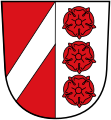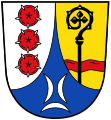Rosenau (noble family)
Rosenau (also Rosenawe, Ritter von Rosenau, noblemen of Rosenawe, Rosenauer ) is the name of a knightly noble family who were wealthy in Oeslau on the outskirts of Rödental and in Coburg , who owned the office of mint master in Coburg from the 15th century at the latest .
history
Origin and possessions
Ancestral seat of the Knights of Rosenawe
The Rosenau family has been documented as knights of Rosenawe since the second half of the 14th century. The Rosenau (Coburg) Castle in Oeslau is 1439 as property of the noble lords of Rosenawe first time in a document of Monastery Sonnenfeld mentioned. The castle could probably have existed before 1430, when the Rosenauer came to the fore by purchasing goods around Coburg. It was common for a noble family to be named after their ancestral seat, here the Rosenau, so that an estate or a bower of this name must have already existed near Oeslau.
The mint master Friedrich von Ouwe , who was proclaimed in 1394 and was a member of the von Ow family , who held this office in Bamberg as early as 1250, probably belongs to the lineage of Rosenawe.
In 1374 the gender was named among the participants in a tournament in Esslingen.
Castles, palaces and houses of those of Rosenau
The family, who were also wealthy in southern Thuringia and in the Gotha area , owned the Coburg mint master's house from 1410 , which the Rosenau residents rebuilt in 1444 as the mint master's three-storey residence, from 1425 the moated castle Mitwitz , 1451 the moated castle Oeslau, 1489 Gauerstadt and a number of manors in the Coburg Country. In 1501 the village and Castle Ahorn were added. In 1516 an Anton von Rosenau was named at Eichhof Castle (Coburg) . The following castles, palaces and houses belonged to those of Rosenau in the course of history:
- Rosenau Castle (Coburg)
- Coburg mint master house
- Mitwitz moated castle in Mitwitz, in the Steinachgrund at the confluence of the Föritz and Steinach
- Gauerstadt, district of Bad Rodach , as well as some manors in the Coburg region
- Ahorn Castle and the Ahorn village
- Eichhof Castle, in the Scheuerfeld (Coburg) district, Eichhof (Coburg) district
- Rosenauer Burg , moated castle in Coburg, from 1434, not far from the outer fortifications of the city of Coburg
Rosenau Castle (Coburg) near Oeslau , emerged from the Rosenau ancestral home
Mint master house in Coburg , from 1410 formerly owned by the mint masters from the noble family of Rosenau
Mitwitz moated castle , once owned by the von Rosenau family (from 1425)
Ahorn Castle , in the municipality of the same name Ahorn (district of Coburg) , owned by the von Rosenau from 1501
The mint masters of Coburg and other Rosenauer
The mint masters Heinz and Günter von Rosenawe, whose title of nobility had been temporarily revoked until 1433 due to an improper lifestyle , acquired several estates near Coburg in 1432 for 6,000 Rhenish guilders from Duke Sigismund von Sachsen . In 1434 they built Rosenau Castle as a moated castle not far from the outer fortifications of the city of Coburg. During this time the brothers were granted the right to strike Coburg coins . In 1456 Sylvester von Rosenau was enfeoffed with Ottenwein and Neida . His descendants later acquired the goods in Thuringia. In 1500 Merten von Rosenau was part of the Stolberg knighthood. Lucas v. R. was canon of Mainz , Worms and Würzburg in 1520 and died in Mainz in 1531. Sylvester II, Heintze and Valentin von Rosenau were assessors at Coburg court around the middle of the 16th century.
For three centuries the name of those von Rosenau, whose wealth was built on agricultural goods, was closely associated with Rosenau Castle on the steep bank of the Itz . In the so-called early capitalism from the end of the 16th century, the big landowners felt the consequences that the flourishing of long-distance trade in connection with industrial publishing brought with it. The economic returns fell alarmingly for the Rosenauer, which led to the increasing indebtedness of the extensive family estates.
Martin von Rosenau sold the Rosenau Castle in Coburg in 1556 as the last owner from the knightly family to Christoph von Hessberg , from whom Duke Johann Casimir acquired the indebted property in 1611 . Sylvester von Rosenau, friend of Luther and Melanchthon , bequeathed Rosenau Castle to his son Hans Berthold and the goods were already heavily in debt. Even this could not lead the legacy to a new bloom, so that his successor Adam Alexander von Rosenau was forced to sell the old castle to Duke Johann Casimir, but was able to reverse the sale in 1637. In 1664 Adam Siegmund von Rosenau died here as a Coburg regional major and war commissioner.
The loss of Rosenau and the extinction of the trunk line
In 1704 the Rosenau family of the same name was finally lost. The Austrian baron Ferdinand Adam von Pernau, in the service of Duke Albrecht since 1690 , acquired Rosenau Castle and its outbuildings as a summer residence and study place for his ornithological research. At that time, the more castle-like property consisted of the palace with a round tower attached to it, the remains of the original ring walls with two defensive tower ruins and the outer bailey with stables, all surrounded by a spacious, overgrown park. Inside the palace there was an arcade building from the 17th century, called the courtyard , which was open to the east and was designed by the Italian master builder Giovanni Bonalino with Gothic elements.
The Rosenau manor near Oeslau belonged to the knightly canton of Baunach , in which the von Rosenau family was enrolled from the time it was acquired. In 1713 a v. Rosenau appears as a Danish major general in Jutland. The last Rosenauer died in 1825 on an estate in Sülzenbrücken in the municipality of Wachsenburg near Gotha.
Name bearer of the lineage
- Heinz and Günter from Rosenawe (lived around 1433), Master of the Mint of nobility to 1433 temporarily because of unseemly conduct disallowed
- Sylvester von Rosenau (lived around 1456), descendants later acquired goods in Thuringia
- Anton von Rosenau (lived around 1517)
- Merten von Rosenau (lived around 1500), belonged to the Stolberg knighthood
- Lucas von Rosenau (lived around 1520; † 1531 in Mainz), Canon of Mainz , Worms and Würzburg
- Sylvester II, Heintze and Valentin von Rosenau (lived around the middle of the 16th century), assessors at the court in Coburg
- Martin von Rosenau (lived around 1556), last owner of the knight family
-
Sylvester von Rosenau, a friend of Luther and Melanchthon , fathered son Hans Berthold
-
Hans Berthold von Rosenau fathered Adam Alexander
- Adam Alexander von Rosenau (lived around 1637)
-
Hans Berthold von Rosenau fathered Adam Alexander
- Adam Siegmund von Rosenau (* before 1664, † 1664), Coburg regional major and war commissioner
- NN von Rosenau (lived around 1713), Danish major general in Jutland
- NN von Rosenau (* before 1825, † 1825 on the estate in Sülzenbrücken near Gotha), the last descendant of the family line of those von Rosenau
Ennobling
The family members of those von Rosenau are notarized as knights of Rosenawe since the second half of the 14th century. The mint masters Heinz and Günter von Rosenawe lost the title of nobility until 1433, temporarily revoked due to an improper lifestyle . In 1500 Merten von Rosenau belonged to the knighthood of the County of Stolberg . The Rosenauer were also enrolled in the knight canton of Baunach .
coat of arms
Blazon : Divided lengthways by silver and red, and on the right and left three roses placed one on top of the other, each with a different color; the crest consists of two silver open buffalo horns each with three red roses, the helmet cover is silver with a red inside.
The coat of arms elements are also found in the municipal coats of arms of the cities of Oeslau and Rödental.
literature
- Walther Heins: Rosenau Castle and its history. In: From Coburg city and country. 1954, ZDB -ID 1256305-5 , pp. 34–40 (reprinted in: Herbert Ott (Red.): 800 years Oeslau. Oeslau community, Oeslau 1962, pp. 47–53).
- Fritz Mahnke: Palaces and castles in the vicinity of the Franconian Crown. Druck- und Verlagsanstalt Neue Presse GmbH, Coburg 1974, pp. 64–68.
- Norbert H. Ott: Rosenau Castle. A noble seat in northern Franconia. New press Coburg, Coburg 1970.
- Richard Teufel: Architectural and art monuments in the district of Coburg. Published by the district of Coburg. Riemann, Coburg 1956.
- Ernst Heinrich Kneschke : New general German nobility lexicon . Volume 7: Ossa - Ryssel . Voigt, Leipzig 1867, p. 582.







